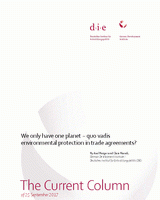We only have one planet – quo vadis environmental protection in trade agreements?
Berger, Axel / Clara BrandiThe Current Column (2017)
Bonn: German Development Institute / Deutsches Institut für Entwicklungspolitik (DIE) (The Current Column of 25 September 2017)
Bonn, 25 September 2017. “Trade Behind the Headlines” is the motto for this year’s World Trade Organization (WTO) Public Forum in Geneva from 26 to 28 September 2017. The annual event gathers trade policy-makers, researchers and representatives of companies and non-governmental organisations from around the world.
Headlines in recent years have been dominated by WTO members’ inability to bring to a successful conclusion the Doha Round of negotiations commenced 16 years ago. Key member states such as the United States are even calling for the languishing talks to be officially abandoned. In response to stagnation in the multilateral negotiations, many countries have opted instead to hammer out trade deals outside of the WTO.
Negotiations of the Transatlantic Trade and Investment Partnership (TTIP) have been the subject of fierce debate in Germany, with many citizens fearing that agreements like TTIP would end up weakening social and environmental standards. However, when we look behind the headlines of the heated trade policy debate, it becomes apparent that the new trade deals contain a whole range of regulations that go beyond the dismantling of trade barriers. The latest data from Canada’s Université Laval shows that 85 per cent of all free trade agreements contain environmental clauses. In fact, recently concluded agreements contain over 60 different environmental provisions.
Environmental provisions – more than mere protectionism
While trade policy actors may be aware of the increase in environmental provisions within trade agreements, they often lack a deeper understanding of their development and diversity across sectors, regions and countries. The pioneering North American Free Trade Agreement (NAFTA), concluded in the early 1990s, contained comprehensive environmental regulations and a side-agreement on environmental issues. Of course, it was not for altruistic reasons alone that the NAFTA member countries incorporated environmental aspects in the agreement. For the United States especially, fear of unfair competition resulting from lax environmental standards in Mexico played an important role. Integrating environmental regulations from the US government alongside labour and social standards also served to mollify domestic critics of NAFTA.
Nonetheless, characterising environmental provisions in trade agreements as concealed protectionism falls short of the mark. The increasing diversity of these provisions in particular indicates the opposite. Working with Jean-Frédéric Morin from Université Laval, the German Development Institute / Deutsches Institut für Entwicklungspolitik (DIE) has developed the online tool TREND analytics, which uses current data to provide a detailed insight into the intricacies of environmental provisions in trade agreements. As a result, it has been found that there are now almost 300 different environmental provisions contained in trade agreements. These include, for example, commitments to implementing national environmental legislation and ratifying international environmental accords, as well as clauses on climate change mitigation, sustainable fishing methods and securing greater participation by civil society actors in environmental policy processes.
Opportunities and risks
To date, it has mainly been the major economic powers, especially the United States, the EU and Canada, which have pushed ahead with integrating environmental issues in free trade agreements. By contrast, developing countries are wary of “green protectionism”, fearing that these environmental provisions are being misused by industrialised nations to keep low-cost products from developing countries out of the market. At the same time, they are now also increasingly seeing the benefits of such provisions. Countries like Costa Rica are stepping up their efforts to integrate environmental aspects into new trade regulations and thereby strengthen environmental protection. The United States-Peru Free Trade Agreement (PTPA), for example, has made a significant contribution to protecting Peru’s forests and conserving their biodiversity.
Greater transparency and mutual learning
Environmental provisions are more than simply a trade policy fig leaf. Consequently, environmental provisions should also be used in future trade accords in order to more effectively harmonise trade and environmental protection – not least as a means of contributing to the implementation of the 2030 Agenda. A greater focus should be placed in public debate on the contribution of trade agreements to promoting sustainable development. The WTO Public Forum in Geneva can play a key role here. In times of polarised and frequently ideological trade-policy controversies, it is important to underpin arguments with evidence and do away with many existing stereotypes. This has the potential to help ensure not only that meaningful environmental provisions are addressed in an increasing number of bilateral and regional free trade agreements, but also that these environmental aspects find their way into multilateral negotiations at the WTO.


